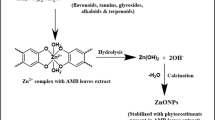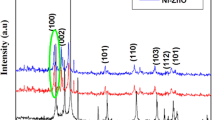Abstract
In the present work, we report a green synthesis of cobalt oxide (Co3O4), bismuth oxide (Bi2O3) and cobalt-doped bismuth oxide (Co-doped BiO) nanoparticles using Bambusa seed extract. The green synthesized nanoparticles are characterized using various techniques such as X-ray diffraction (XRD), Fourier transform infrared spectroscopy (FTIR), UV–visible spectroscopy and field emission scanning electron microscopy (FESEM). The phase purity of the synthesized nanoparticles is confirmed with the aid of XRD analysis, and the crystallite sizes are found to be 10.42 nm, 18.85 nm and 61.23 nm for Co3O4, Bi2O3 and Co-doped BiO nanoparticles, respectively. Bond length calculations and functional group analysis are done by FTIR technique. The UV–visible analysis depicts higher optical absorption and band gaps varying from 1.81, 2.65 and 1.87 eV for Co3O4, Bi2O3 and Co-doped BiO nanoparticles, respectively. Changes in the surface morphology are observed from FESEM analysis. In addition, the samples' catalytic efficiency in the breakdown of methylene blue (MB) dye was studied and the effects of various process parameters on the extent of dye removals such as photocatalyst amount, irradiation period, the concentration of dye and pH of the solution were also studied. The pseudo-first-order MB photocatalytic decomposition kinetic model has a high correlation coefficient value (R2 > 0.95). The findings support the use of a Co-doped BiO in the field of photocatalytic applications under natural sunlight.












Similar content being viewed by others
References
Akhoondi A, Ziarati M (2014) Hydrothermal production of highly pure nano pyrite in a stirred reactor. J Chem Eng 33:15–19
Anandan M, Dinesh S, Krishnakumar N, Balamurugan K (2016) Influence of Co doping on combined photocatalytic and antibacterial activity of ZnO nanoparticles. Mater Res Express 3:115009
Asif SAB, Khan SB, Asiri AM (2014) Efficient solar photocatalyst based on cobalt oxide/iron oxide composite nanofibers for the detoxification of organic pollutants. Nanoscale Res Lett 9:510
Badger RM (2004) The relation between the internuclear distances and force constants of molecules and its application to polyatomic molecules. J Chem Phys 3:710
Bettinelli M, Dallacasa V, Falcomer D, Fornasiero P, Gombac V et al (2007) Photocatalytic activity of TiO2 doped with boron and vanadium. J Hazard Mater 146:529–534
Bisht NS, Tripathi AH, Kumar S et al (2021) Silver oxide-bismuth oxy bromide nanocomposites as an excellent weapon to combat with opportunistic human pathogens. J Photochem Photobiol 6:100031
Bulla SS, Bhajantri RF, Chavan C, Sakthipandi K (2022) Biosynthesized silver nanoparticles encapsulated in a poly(vinyl alcohol)matrix: dielectric and structural properties. Chem Sel 7:47
Byrappa K, Subramani AK, Ananda S et al (2006) Photocatalytic degradation of rhodamine B dye using hydrothermally synthesized ZnO. Bull Mater Sci 29:433–438
Daneshvar N, Salari D, Khataee AR (2004) Photocatalytic degradation of azo dye acid red 14 in water on ZnO as an alternative catalyst to TiO2. J Photochem Photobiol A Chem 162:317–322
Daniel T, Balasubramanian V, Joy Jeba Vijila J, Nishanthi ST et al (2022) Photoelectrochemical and photovoltaic cell performances of thermally evaporated Cu3BiS3 thin films. Vacuum 195(5):110707
Dhanalakshmi A, Natarajan B, Ramadas V, Palanimurugan A et al (2016) Structural, morphological, optical and antibacterial activity of rod-shaped zinc oxide and manganese-doped zinc oxide nanoparticles. Pramana 874(87):1–9
Farhadi S, Javanmard M, Nadri G (2016a) Characterization of cobalt oxide nanoparticles prepared by the thermal decomposition. Acta Chim Slov 63:335–343
Farhadi S, Javanmard M, Nadri G (2016b) Characterizatiom of cobalt oxide nanoparticles prepared by the thermal decomposition of [Co(NH3)5(H2O)](NO3)3 complex and study of their photocatalytic activity. Acta Chim Slov 63(2):335–343
Farrukh MA, Butt KM, Chong KK, Chang WS (2019) Photoluminescence emission behavior on the reduced band gap of Fe doping in CeO2–SiO2 nanocomposite and photophysical properties. J Saudi Chem Soc 23:561–575
Ferin Fathima A, Jothi Mani R, Sakthipandi K, Manimala K, Hossain A (2019) Enhanced antifngal activity of pure and iron-doped ZnO nanoparticles prepared in the absence of reducing agents. J Inorg Organomet Polym Mater 30:2397
Ferin Fathima A, Jothi Mani R, Mohamed Roshan M, Sakthipandi K (2021) Enhancing structural and optical properties of ZnO nanoparticles induced by the double co-doping of iron and cobalt. Mater Today Proc 49:2598
Fujishima A, Zhang X, Tryk DA (2007) Photocatalysis by inorganic solid materials. Int J Hydrogen Energy 32:2664–2672
Gowri Manoharin R, Saravanamoorthy MD, PoongodiVijayakumar T, Vijayan B (2016) Preliminary phytochemical analysis of bamboo seed. World J Pharm Pharm Sci 4:1336–1342
Grzechulska J, Morawski AW (2002) Photocatalytic decomposition of azo-dye acid black 1 in water over modified titanium dioxide. Appl Catal B Environ 36:45–51
Hafeez M, Shaheen R, Akram B, Haq S, Mahsud S, Ali S, Khan R (2020) Green synthesis of cobalt oxide nanoparticles for potential biological applications. Mater Res Exp 7(2):025019
Haick H, Paz Y (2001) Remote photocatalytic activity as probed by measuring the degradation of self-assembled monolayers anchored near microdomains of titanium dioxide. J Phys Chem B 105:3045–3051
Haque MM, Bahnemann D, Muneer M (2012) Photocatalytic degradation of organic pollutants: Mechanisms and kinetics photocatalytic degrade. Org Pollut Mech Kinet 3:294–326
He HY, Dong WX, Zhang GH (2010) Photodegradation of aqueous methyl orange on MnTiO3 powder at different initial pH. Res Chem Intermed 36:995–1001
Herrmann JM (1995) Heterogeneous photocatalysis: an Emerging discipline involving multiphase systems. Catal Today 24(1–2):157–164
Hou J, Wang Z, Kan W, Jiao S, Zhu H, Kumar RV (2012) Efficient visible-light-driven photocatalytic hydrogen production using CdS@TaON core–shell composites coupled with graphene oxide nanosheets. J Mater Chem 22:7291–7299
Irfan Ali S, Li L, Saleemi A, Nan C (2017) Enhanced photocatalytic activity of La3+ and Se4+ co-doped Bismuth Ferrites nanostructures. J Mater Chem A 1–10
Ismat B, Nosheen N, Munawar I, Shagufta K, Haq N, Shazia N et al (2017) Green and eco-friendly synthesis of cobalt-oxide nanoparticle: characterization and photo-catalytic activity. Adv Powder Technol 28:2035–2043
Jeevanantham N, Balasundaram ON (2019) High-performance visible light photocatalytic activity of cobalt (Co) doped CdS nanoparticles by wet chemical route. J Iran Chem Soc 16:243–251
Kaupp M, Danovich D, Shaik S (2017) Chemistry is about energy and its changes: a critique of bond-length/bond-strength correlations. Coord Chem Rev 344:355–362
Kikuchi Y, Sunada K, Iyoda T, Hashimoto K, Fujishima A (1997) Photocatalytic bactericidal effect of TiO2 thin films: dynamic view of the active oxygen species responsible for the effect. J Photochem Photobiol A Chem 106:51–56
Kirankumar VS, Sumathi S (2017) Catalytic activity of bismuth doped zinc aluminate nanoparticles towards environmental remediation. Mater Res Bull 93:74–82
Kuriakose S, Satpati B, Mohapatra S (2014) Enhanced photocatalytic activity of Co doped ZnO nanodisks and anorods are prepared by a facile wet chemical method. Phys Chem Chem Phys 16:12741–12749
Liu G, Zhao Y, Sun C, Li F, Qing LuG, Cheng H (2008) Synergistic effects of B/N doping on the visible-light photocatalytic activity of mesoporous TiO2. Angew Chemie Int Ed 47:4516–4520
Liu X, Cao H, Yin J (2011) Generation and photocatalytic activities of Bi@Bi2O3 microspheres. Nano Res 4:470–482
Ma D, Zhao J, Zhao Y, Hao X, Li L, Zhang L, Lu Y, Yu C (2012) Synthesis of bismuth nanoparticles and self-assembled nanobelts by a simple aqueous route in basic solution. Colloids Surf A Physicochem Eng Asp 395:276–283
Memon SA, Hassan D, Buledi JA, Solangi AR, Memon SQ, Palabiyik IM (2020) Plant material protected cobalt oxide Nanoparticles Sensitive electro- catalyst for tramadol detection. Microchem J 159:105480
Mengyue Z, Shifu C, Yaowu T (1995) Photocatalytic degradation of organophosphorus pesticides using thin films of TiO2. J Chem Technol Biotechnol 64:339–344
Ming L (2000) Treatment of dye aqueous solution by UV/TiO2 process with applying bias potential. WaterSci 36:106–189
Novinrooz Sarabadani P, Garousi J (2006) Characterization of pure and antimony doped SnO2 thin films prepared by the sol–gel technique. Iran J Chem Chem Eng 25(2):31–38
Okpara M (2018) Biofabrication of cobalt nanoparticles using leaf extract of Chromonaela odorata and their potential antibacterial application conversion of wastes to renewable energy view project phytochemistry view project Okenwa Igwe Res. J Chem Sci 8:11–17
Petcharoen K, Sirivat A (2012) Synthesis and characterization of magnetite nanoparticles via the chemical co-precipitation method. Mater Sci Eng B 177:421–427
Ponchitra A, Balasubramanian K, Jothi Mani R, Sakthipandi K (2021) Structural, mechanical, dielectric, thermal, and nonlinear optical properties of zinc-doped ninhydrin single crystals. Indian J Phys 1:9
Rajput P, Deshpande MP, Bhoi HR, Suchak NM, Desai PH, Chaki SH (2022) Photocatalytic and antibacterial activity of Yttrium doped TiO2 nanostructure. Chem Phys Impact 5:100101
Raza W, Haque MM, Muneer M, Harada T, Matsumura M (2015) Synthesis, characterization and photocatalytic performance of visible light induced bismuth oxide nanoparticle. J Alloys Compd 648:641–650
Samuel MS, Selvarajan E, Mathimani T et al (2020) Green synthesis of cobalt-oxide nanoparticle using jumbo Muscadine (Vitis rotundifolia): characterization and photo-catalytic activity of acid Blue-74. J Photochem Photobiol B Biol 211:112011
Schlesinger M, Schulze S, Hietschold M, Mehring M (2012) Metastable β-Bi2O3 nanoparticles with high photocatalytic activity from polynuclear bismuth oxide clusters. Dalt Trans 42:1047–1056
Shume WM, Murthy HCA, Zereffa EA (2020) A review on synthesis and characterization of Ag2O nanoparticles for photocatalytic applications. J Chem 2020:1–15
Stengl V, Bakardjieva S (2010) Molybdenum-doped anatase and its extraordinary photocatalytic activity in the degradation of orange II in the UV and vis regions. J Phys Chem C 114:19308–19317
Tahir MB, Iqbal TK, Habiba HA (2019) Insighting role of reduced graphene oxide in BiVO4 nanoparticles for improved photocatalytic hydrogen evolution and dyes degradation. Int J Energy Res 43:1–8
Tatsuma T, Tachibana SI, Fujishima A (2001) Remote oxidation of organic compounds by UV-irradiated TiO2 via the gas phase. J Phys Chem B 105:6987–6992
Thaweesaeng N, Supankit S, Techidheera W, Pecharapa W (2013) Structure properties of As-synthesized Cu-doped ZnO nanopowder synthesized by co-precipitation method. Energy Procedia 34:682–688
Vasanth Kumar K, Porkodi K, Selvaganapathi A (2007) Constrain in solving Langmuir–Hinshelwood kinetic expression for the photocatalytic degradation of Auramine O aqueous solutions by ZnO catalyst. Dye Pigment 75:246–249
Viruthagiri G, Kannan P (2019) Visible light mediated photocatalytic activity of cobalt doped Bi2O3 nanoparticles. Mater Res Technol 8:127–133
Wang R, Lai TP, Gao P, Zhang H, Ho PL, Woo PCY, Ma G et al (2018) Bismuth antimicrobial drugs serve as broad-spectrum metallo-β-lactamase inhibitors. Nat Commun 9:439
Wan-Kuen J, Santosh K, Isaacsb MA, Leeb AF, Karthikeyan S (2017) Cobalt promoted TiO2/GO for the photocatalytic degradation of oxytetracycline and Congo Red. Appl Catal B Environ 201:159–168
Yamashita H, Harada M, Misaka J, Takeuchi M, Neppolian M, Anpo M (2003) Photocatalytic degradation of organic compounds diluted in water using visible light-responsive metal ion-implanted TiO2 catalysts: Fe ion-implanted TiO2. Catal Today 84:191–196
Zhang X, Zhou G, Zhang H, Wu C, Song H (2011) Characterization and activity of visible light– driven TiO2 photocatalysts co- doped with nitrogen and lanthanum. Transit Met Chem 362(36):217–222
Acknowledgements
The authors are grateful to the Department of Chemistry at V.O. Chidambaram College for providing FTIR and UV. The authors are thankful to Avinashilingam University in Coimbatore for providing FESEM. The authors express gratitude to the administration of V.O. Chidambaram College for providing the necessary supplies for this work.
Funding
The authors have not disclosed any funding.
Author information
Authors and Affiliations
Corresponding author
Ethics declarations
Conflict of Interest
The authors declare that there is no conflict of interest associated with this study.
Supplementary Information
Below is the link to the electronic supplementary material.
Rights and permissions
Springer Nature or its licensor (e.g. a society or other partner) holds exclusive rights to this article under a publishing agreement with the author(s) or other rightsholder(s); author self-archiving of the accepted manuscript version of this article is solely governed by the terms of such publishing agreement and applicable law.
About this article
Cite this article
Vathana, S.A., Amudhavalli, K. & Daniel, T. Rapid Crystal Structural, Optical and Morphological Studies of Transition Metal Oxide Nanoparticles and their Photocatalytic Activity. Iran J Sci 47, 1407–1420 (2023). https://doi.org/10.1007/s40995-023-01483-x
Received:
Accepted:
Published:
Issue Date:
DOI: https://doi.org/10.1007/s40995-023-01483-x




